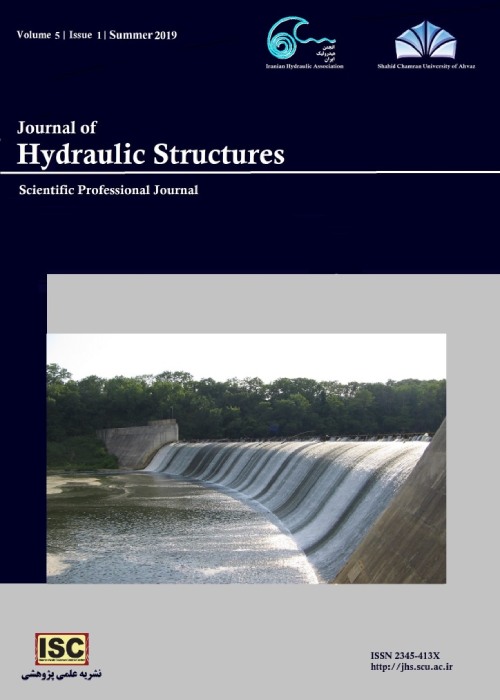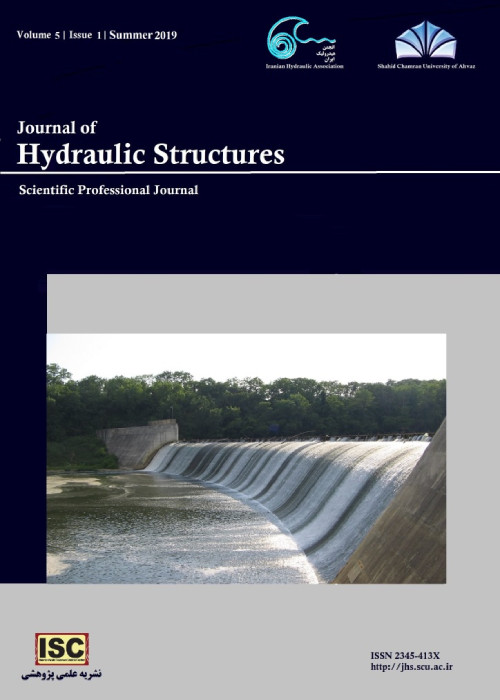فهرست مطالب

Journal of Hydraulic Structures
Volume:8 Issue: 3, Autumn 2022
- تاریخ انتشار: 1402/01/06
- تعداد عناوین: 6
-
-
Pages 1-16In many developing countries, insufficient water treatment forces the people to use the home point of use (POU) systems. A scientific review was conducted for all articles published on POU for Iranian cities. This study focuses on the effect of the POU systems on water quality. The related data were collected according to the inclusion and exclusion criteria and by searching. Supported the searched keywords with emphasis on the type of water treatment system and the type of incoming water, the obtained articles were reviewed. The qualitative data were collected employing a preferred reporting items for systematic reviews and Meta-analyzes (PRISMA) standard checklist. 544 article titles were found within the initial search with the keywords listed. Finally, after reviewing the knowledge and quality of the articles, 20 articles were eligible for systematic review. the most important number of articles were published between 2012 and 2021. In some cities, EC, TDS and total hardness were high, which reached the specified standard after leaving the POU systems. But since these systems reduce all parameters and are not selective, they greatly reduce the quantity of chlorine, fluoride and sometimes TDS and pH. As chlorine decreases, the quantity of microbial contamination in the effluent increases. By reducing the fluoride within the effluent, the health of the teeth and bones is compromised over time. Therefore, on time replacement of all filters is essential and consumers and operators of these systems should be trained enough in the field of water quality standards and guidelines.Keywords: Systematic Review, point of use, Household water treatment systems, water quality
-
Pages 17-32Pivot weirs have a lifting mechanism to change the weir angle relative to the channel bed. These are installed across the waterways in the form of multiple weirs in a row. The water level will be adjusted by changing the weir angle. In this study, the flow over the pivot weirs was simulated with different flow discharges and angles using Ansys CFX model to investigate the flow characteristics. The model was evaluated using USBR experimental data. The standard K-ε turbulence model was considered as the best model for numerical analysis. According to the results, discharge coefficient increases with the inclination angle up to 1.076. The results showed a slight difference in comparison with the previous studies where values of 1.121, 1.110 and 1.082 were presented. The discharge coefficient equations were developed for the weirs. The equations for various hydraulic parameters, including upstream water depth, water head on the crest, the ratio of water head over the crest to the weir height, and weir angle were developed. Based on the developed equations, the operation of the weirs was analyzed during flood events.Keywords: Numerical model, Pivot weir, Ansys CFX, K- model, Inclined weir
-
Pages 33-55Fixed marine structures is widely utilized as production or oil recovering platform in the shallow sea, and are also subject to random loading. Jacket structures subject to random loading pose difficulties in both analysis and design, with solutions commonly only viably acquired employing a numerical technique. Performance of offshore jacket platforms is highly related to configuration of the braces. In this regard, probabilistic scheme is a good option for evaluating jacket structures. In this paper, the performance of Resalat jacket structure located in the Persian Gulf with different kinds of bracing configuration is investigated. We present a new measuring index for optimum arrangement of bracing configuration which is defined as probabilistic design criterion. The Latin Hypercube Sampling (LHS) method, which is a more advanced and appropriate form of the Monte Carlo simulation technique, is used to investigate different configurations. Hereof, probabilistic analysis is performed on different configurations of platform structure using the LHS method. The elastic modulus is employed as the random input variable for probabilistic analysis, and the maximum values of stress and horizontal displacement are selected as the random output variables. Also, at the end of the calculations, the optimum configuration can be found. It is demonstrated that the proposed probabilistic optimization algorithm is capable of effectively determining the optimum configuration of jacket platform structures. Therefore, an optimum bracing configuration can be useful in evaluating and designing the fixed marine structures.Keywords: Offshore platform, Optimum configuration, Probabilistic design, Reliability, Best arrangement for bracing
-
Pages 56-71Lagrangian approaches such as the Moving Particle Semi-Implicit method and Smoothed particle Hydrodynamics are the latest techniques in Computational Fluids Dynamics and have attracted the attention of many researchers. Due to the Lagrangian nature of such practices, they can simulate various problems with large deformations and a variety of boundary conditions which has led to their application in many complex engineering problems. Therefore, the accuracy of the results obtained using these methods is substantial, while various parameters affect the accuracy of the simulation. In this paper, the sensitivity of a dam-break flow simulated by the Weakly Compressible Moving Particle Semi-Implicit method associated with the particle size and Courant number is analyzed. The analysis is performed in two circumstances. First, the Courant number is fixed, and the sensitivity relative to particle size is investigated. Then, sensitivity relative to the Courant number is studied in fixed particle size. In general, it can be concluded that the smaller the particle size and Courant number, the higher accuracy and computational cost.Keywords: Dam-Break Problem, Lagrangian Methods, Sensitivity analysis, Weakly Compressible Moving Particle Semi-Implicit Method
-
Pages 72-87Severe local differential displacements and the resulting high stresses in the slabs-on-grade in hydraulic structures are often caused by the displacement of bottom layers with cracks and joints or the presence of swollen soils. In addition to the above factors, the uplift due to hydrostatic and hydrodynamic pressure due to water flow under the slabs can also cause differential displacements. In this research, a ductile anchorage system with high deformable concrete element is introduced and using the designed setup, its effectiveness in comparison with conventional elastic anchorage system in the slabs under a wide uniform uplift load has been studied. High deformable concrete elements have the same strength as ordinary concrete but their compressive strain can reach 60%. These types of concrete elements are in the form of precast elements, which have many applications in structures. At first, to obtain a proper high deformable concrete element, several tests were carried out on various samples and compositions, and the behavior of the high deformable elements was studied and achieved. Experimental and numerical results show that the rate of energy absorption in deformable anchorage systems is 4 times that of conventional elastic anchors, and the use of ductile supports can prevent cracking of slabs in hydraulic structures.Keywords: Concrete Slab, Ductile Anchorage System, High Deformable Concrete, Hydraulic structures, Uplift Pressure
-
Pages 88-107
Dam's weir is one of the most important dam structures that play a significant role in flood routing in the dam reservoir. Since the dam's level significantly affects the storage, changing the level and increasing its height can increase storage volume and flood control in some situations. Shahid Abbaspour Dam (Karoon 1), due to the reduction of the dam volume, affected by the accumulation of sediments and the construction of upstream reservoir dams, it is necessary to increase the dam's weir height. This research used a numerical simulation of the weir with Flow3D software. Moreover finally, after the model verification, its height was increased. All model outputs were compared with the physical model results and the dam's data, and the simulation fit well with both systems. According to the model results, in exchange for changing the level of the dam from 510 to 513.5 and the fully opening of the Gates, no negative pressure is created on the weir surface, and the cavitation index is within the allowable range.
Keywords: Dam, Ogee Spillway, Flood Control, Flow3D, Karoon 1


